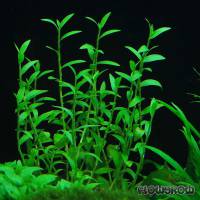



In Europe, this plant was introduced into trade under the erroneous name "Arthraxon spec.". Arthraxon is a genus in the true grass family (Poaceae). The plant sold under the name "Arthraxon" in Asia and the USA was identified as Sphaerocaryum malaccense (a true grass), however, the plant presented here might look similar but is not a true grass. Instead, it belongs to the Commelinaceae family.
Thomas Rudolph (the Netherlands) has found some blue flowers on plants that were cultivated emersed, which fit the characteristics of the genus Cyanotis. The other characteristics of the plant also point in that direction, however, its exact species has not been determined yet. It was probably imported from South-East Asia.
The genus Cyanotis contains over 50 species that are found in the Asian and African tropics and subtropics down to northern Australia. They grow in moist to dry habitats. Cyanotis axillaris and C. cristata are e.g. poften found in wetlands and - as weeds - in rice paddies.
Cyanotis sp. is a relatively fast-growing marsh plant with a creeping growth habit. However, when cultivated submersed it is a relatively slow grower and forms distinctly smaller, shorter leaves on upright, straight stems. It resembles Murdannia keisak (which also belongs to the Commelinaceae family), but stays smaller and more delicate in its submersed as well as in its emersed form. The somewhat succulent leaves are lanceolate and grow alternating in two rows.
In the aquarium the straight, upright stems remind the onlooker of bamboo stems.
Cyanotis sp. can be cultivated emersed without any problems as long as the substrate is moist and rich in nutrients and can thus be used in terraria and paludaria, where it can e.g. grow into the water part.
- To be continued -
<a href="https://www.flowgrow.de/db/aquaticplants/cyanotis-sp" target="_blank"><img alt="Cyanotis sp." title="Cyanotis sp." src="https://www.flowgrow.de/db/widget/aquaticplants/cyanotis-sp" /></a>
[url=https://www.flowgrow.de/db/aquaticplants/cyanotis-sp][img]https://www.flowgrow.de/db/widget/aquaticplants/cyanotis-sp[/img][/url]
[widget=aquaticplants/cyanotis-sp]Cyanotis sp.[/widget]